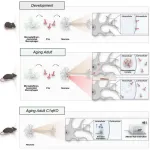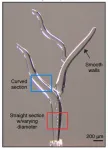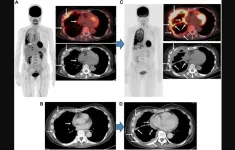(Press-News.org) Overall rates of long-term survival following stroke are improving, but Black individuals experience worse long-term outcomes compared to white individuals, according to University of Cincinnati research published online July 15 in Neurology®, the medical journal of the American Academy of Neurology.
UC’s David Robinson, MD, corresponding author on the research, said prior studies had examined short-term stroke outcomes of 30 or 60 days, but this time the team looked at survival rates five years past a person’s stroke.
“This was the first attempt to look at a much longer period of follow-up time after a stroke, since a lot of the interventions we’ve come up with have more effect long term than they do in the short term,” said Robinson, a UC Gardner Neuroscience Institute physician researcher and assistant professor in the Department of Neurology and Rehabilitation Medicine in UC’s College of Medicine. “We’ve never been able to show that outcomes from strokes were definitively improving over longer periods of time.”
Researchers pulled data from the Greater Cincinnati Northern Kentucky Stroke Study, which has been following stroke epidemiology in a five-county region in Greater Cincinnati since 1993. Robinson said this area is a microcosm of the United States, representing similar representations of race, educational attainment and socioeconomic status as the country as a whole.
Among patients with acute ischemic stroke, the most common type of stroke, five-year mortality after stroke improved from 53% in 1993-94 to 48.3% in 2015, an absolute decline nearly double what would be expected in the general population. There were no changes in five-year survival for patients following an intracerebral hemorrhage, the most severe type of stroke.
“For the first time, we saw that there clearly has been an improvement in five-year mortality after stroke, and it probably is at least partially driven by the stroke systems of care that have been set up here in Cincinnati,” Robinson said. “The data suggests that we have specific interventions in the care of stroke that are disproportionately improving mortality for that particular group of people.”
While the overall numbers are improving, Black individuals were found to be 20% more likely to die within five years after an ischemic stroke than white individuals. Previous research confirmed that strokes are more common in Black individuals, but this research found for the first time that long-term outcomes are worse for Black patients.
Robinson said there is no singular cause for the overall improvement in mortality, but the combination of new treatments and establishing a more comprehensive system of stroke care have contributed. Similarly, a number of different long-term social, economic and environmental inequities likely contribute to worse outcomes for Black patients.
Moving forward, Robinson said this data makes clear that ongoing follow-up and monitoring of patients following a stroke are critical to continue to improve long-term survival, especially among Black patients.
“This includes making sure that they’re on the right medications to minimize their chances of having an additional stroke; keeping them on the medications we know help, including cholesterol medications; and keeping their blood pressure under control,” he said.
Additionally, more people surviving strokes probably means more people living with disabilities caused by their strokes, highlighting the need for ongoing and improving rehabilitation services such as UC’s Stroke Recovery Clinic.
“If we’re helping people survive more, we’re going to have to come up with better treatments to help them with their disability, and that’s a big focus of our rehab group here, which I think is critical,” Robinson said. “I don’t think there’s any way you can look at this data and not be concerned about the number of people who are going to be surviving and need some help in terms of getting them as functional as we can.”
Coauthors on the study include UC’s Robert Stanton, Heidi Sucharew, Mary Haverbusch, Lisa Nobel, Pooja Khatri, Joseph Broderick, Simona Ferioli, Daniel Woo, Matthew Flaherty, Stacie Demel, Kyle Walsh, Eva Mistry and Brett Kissela; Lili Ding and Jane Khoury of Cincinnati Children’s Hospital; George Howard of the University of Alabama at Birmingham; Opeolu Adeoye of Washington University; Jason Mackey of Indiana University; Felipe De Los Rios La Rosa of Miami Neuroscience Institute; Sabreena Slavin of the University of Kansas; Michael Star of Soroka Medical center; Sharyl Martini of the VA National TeleStroke Program; Elisheva Coleman of the University of Chicago; Adam Jasne of Yale University; and Dawn Kleindorfer of the University of Michigan
END
University of Cincinnati study: Long-term stroke survival improving, but racial disparities remain
Research published in the journal Neurology
2024-07-15
ELSE PRESS RELEASES FROM THIS DATE:
National Institutes of Health grant could mean progress toward improved outcomes for stroke patients
2024-07-15
The Associate Dean of Research at the University of Tennessee Health Science Center’s College of Nursing has received a two-year, $421,188 grant from the National Institutes of Health (NIH) to improve cognitive screening in people who suffer from a devastating type of stroke called aneurysmal subarachnoid hemorrhage (aSAH).
Professor Ansley Stanfill, PhD, RN, FAAN, has devoted her program of research to improving outcomes for people who survive strokes. Her latest grant aims to determine if an existing screening tool can be used in a new way to assess patients following aSAH and trigger a ...
SfN establishes James L. Roberts Endowed Fund
2024-07-15
Washington, D.C. – The Society for Neuroscience (SfN) has received $128,000 from the estate of James L. Roberts, PhD. With the funds, SfN Council voted to create a new long-term endowed fund, The James L. Roberts Fund, and will use the income from its investments to create and perpetually fund James L. Roberts Trainee Professional Development Awards (TPDAs) beginning at Neuroscience 2024.
“I knew Jimmy Roberts very well. We basically launched neurobiology at Sinai when we co-directed the Fishberg Research Center for Neurobiology at Mount Sinai from 1989–2002,” said incoming SfN President John Morrison. “Jimmy was an outstanding ...
Unlocking the mystery of preexisting drug resistance: New study sheds light on cancer evolution
2024-07-15
CLEVELAND—The evolution of resistance to diseases, from infectious illnesses to cancers, poses a formidable challenge.
Despite the expectation that resistance-conferring mutations would dwindle in the absence of treatment due to a reduced growth rate, preexisting resistance is pervasive across diseases that evolve—like cancer and pathogens—defying conventional wisdom.
In cancer, it is well known that small numbers of drug-resistant cells likely exist in tumors even before they’re treated. In something of a paradox, before treatment, these mutants have been repeatedly shown to have lower fitness than the surrounding ancestor cells from which they arose. It leads ...
New study reveals critical role of C1q protein in neuronal function and aging
2024-07-15
BOSTON, Mass. (July 15, 2024)—A groundbreaking study conducted at the lab of Beth Stevens, PhD, at Boston Children’s Hospital has revealed that an immune protein impacts neuronal protein synthesis in the aging brain. Previous work from the Stevens lab had uncovered that immune cells in the central nervous system, microglia, help prune synapses in the developing brain by tagging synapses with the immune protein C1q. New research led by Nicole Scott-Hewitt, published in Cell, shows that neurons can also internalize C1q. C1q seems to influence protein production inside neurons by interacting with ribosomal proteins, RNA-binding proteins, and ...
New research demonstrates potential for increasing effectiveness of popular diabetes, weight-loss drugs
2024-07-15
A network of proteins found in the central nervous system could be harnessed to increase the effectiveness and reduce the side effects of popular diabetes and weight-loss drugs, according to new research from the University of Michigan.
The study, appearing today in the Journal of Clinical Investigation, focused on two proteins called melanocortin 3 and melanocortin 4 found primarily on the surface of neurons in the brain that play a central role in regulating feeding behavior and maintaining the body's energy balance.
Melanocortin ...
Understanding the 3D ice-printing process to create micro-scale structures
2024-07-15
Advances in 3D printing have enabled many applications across a variety of disciplines, including medicine, manufacturing, and energy. A range of different materials can be used to print both simple foundations and fine details, allowing for the creation of structures with tailored geometries.
However, creating structures with micro-scale, precise internal voids and channels still poses challenges. Scaffolds used in tissue engineering, for example, must contain a three-dimensional complex network of conduits that mimic the human vasculature. With traditional additive manufacturing, where the material is deposited layer ...
Children’s Hospital of Philadelphia researchers develop antioxidant strategy to address mitochondrial dysfunction caused by SARS-CoV-2 virus
2024-07-15
Philadelphia, July 15, 2024 – Building upon groundbreaking research demonstrating how the SARS-CoV-2 virus disrupts mitochondrial function in multiple organs, researchers from Children’s Hospital of Philadelphia (CHOP) demonstrated that mitochondrially-targeted antioxidants could reduce the effects of the virus while avoiding viral gene mutation resistance, a strategy that may be useful for treating other viruses. The preclinical findings were recently published in the journal Proceedings ...
How climate change is altering the Earth’s rotation
2024-07-15
Climate change is causing the ice masses in Greenland and Antarctica to melt. Water from the polar regions is flowing into the world’s oceans –and especially into the equatorial region. “This means that a shift in mass is taking place, and this is affecting the Earth’s rotation,” explains Benedikt Soja, Professor of Space Geodesy at the Department of Civil, Environmental and Geomatic Engineering at ETH Zurich.
“It’s like when a figure skater does a pirouette, first holding her arms close to her body and then stretching ...
Comparison of FDG-PET/CT and CT for treatment evaluation of patients with unresectable malignant pleural mesothelioma
2024-07-15
“FDG-PET is generally considered as a useful metabolic evaluation tool, while it is also thought to have an emerging role for assessment of systemic therapy response.”
BUFFALO, NY- July 15, 2024 – A new research paper was published in Oncotarget's Volume 15 on June 20, 2024, entitled, “Comparison of FDG-PET/CT and CT for evaluation of tumor response to nivolumab plus ipilimumab combination therapy and prognosis prediction in patients with unresectable malignant pleural mesothelioma.”
Malignant pleural mesothelioma (MPM) is an aggressive neoplasm and affected ...
New concept explains how tiny particles navigate water layers – with implications for marine conservation
2024-07-15
A new UBC study published recently in Proceedings of the National Academy of Science (PNAS) has unveiled insights into how microscopic organisms such as marine plankton move through water with different density layers.
Researchers Gwynn Elfring and Vaseem Shaik found that density layers, created by variations in temperature or salinity, influence the swimming direction and speed of tiny particles navigating a liquid.
Pushers and pullers
“There are two different types of microscopic swimmers – ...
LAST 30 PRESS RELEASES:
Simple method can enable early detection and prevention of chronic kidney disease
S-species-stimulated deep reconstruction of ultra-homogeneous CuS nanosheets for efficient HMF electrooxidation
Mechanical and corrosion behavior of additively manufactured NiTi shape memory alloys
New discovery rewrites the rules of antigen presentation
Researchers achieve chain-length control of fatty acid biosynthesis in yeast
Water interactions in molecular sieve catalysis: Framework evolution and reaction modulation
Shark biology breakthrough: Study tracks tiger sharks to Maui mating hub
Mysterious iron ‘bar’ discovered in famous nebula
World-first tool reduces harmful engagement with AI-generated explicit images
Learning about public consensus on climate change does little to boost people’s support for action, study shows
Sylvester Cancer Tip Sheet for January 2026
The Global Ocean Ship-Based Hydrographic Investigations Program (GO-SHIP) receives the Ocean Observing Team Award
Elva Escobar Briones selected for The Oceanography Society Mentoring Award
Why a life-threatening sedative is being prescribed more often for seniors
Findings suggest that certain medications for Type 2 diabetes reduce risk of dementia
UC Riverside scientists win 2025 Buchalter Cosmology Prize
SETI Institute opens call for nominations for the 2026 Tarter Award
Novel theranostic model shows curative potential for gastric and pancreatic tumors
How beige fat keeps blood pressure in check
Fossils reveal ‘latitudinal traps’ that increased extinction risk for marine species
Review: The opportunities and risks of AI in mental health research and care
New map reveals features of Antarctic’s ice-covered landscape
Beige fat promotes healthy vascular function and blood pressure in mice
Chronic low-dose pesticide exposure reduces the life span of wild lake fish, China-based study shows
Tiny earthquakes reveal hidden faults under Northern California
Long-term pesticide exposure accelerates aging and shortens lifespan in fish
Professor Tae-Woo Lee's research group develops groundbreaking perovskite display technology demonstrating the highest efficiency and industry-level operational lifetime
The “broker” family helps tidy up the cell
Ecology: Mummified cheetahs discovery gives hope for species’ Arabic reintroduction
Researchers survey the ADHD coaching boom
[Press-News.org] University of Cincinnati study: Long-term stroke survival improving, but racial disparities remainResearch published in the journal Neurology






